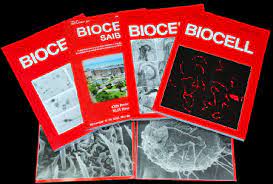View Item
- xmlui.general.dspace_homeCentros e Institutos de InvestigaciónCIRN. Centro de Investigaciones de Recursos NaturalesInstituto de Recursos BiológicosArtículos científicosxmlui.ArtifactBrowser.ItemViewer.trail
- DSpace Home
- Centros e Institutos de Investigación
- CIRN. Centro de Investigaciones de Recursos Naturales
- Instituto de Recursos Biológicos
- Artículos científicos
- View Item
Storage lipids and proteins of Euterpe edulis seeds
Abstract
Comparative studies on fatty acid and protein composition of the endosperm and embryo of palmito (Euterpe edulis Martius) were conducted using gas-liquid chromatography and sodium dodecyl sulfate– polyacrylamide gel electrophoresis. On a dry weight basis, the embryo contained extremely lower amounts of lipids and proteins than did the endosperm, which was associated with the scarce lipid and protein bodies previously reported in axis and cotyledon. The
[ver mas...]
Comparative studies on fatty acid and protein composition of the endosperm and embryo of palmito (Euterpe edulis Martius) were conducted using gas-liquid chromatography and sodium dodecyl sulfate– polyacrylamide gel electrophoresis. On a dry weight basis, the embryo contained extremely lower amounts of lipids and proteins than did the endosperm, which was associated with the scarce lipid and protein bodies previously reported in axis and cotyledon. The fatty acid composition also exhibited differences between
both tissues: (I) the fatty acid diversity was greater in embryo than in endosperm; (II) embryo and endosperm contained predominantly linoleic, palmitic, oleic and stearic acids even though the relative values were different for each tissue. As compared to other palm species, the higher fatty acid unsaturation in Euterpe edulis seed could be involved in the previously reported short longevity and recalcitrant behavior during storage.
Proteins of both tissues were heterogeneous in molecular mass. Some proteins were tissue-specific, but other were common, among them a highly glycosylated protein which migrated at about 55 kDa. We hypothesize that the latter, also reported in all previously studied palm species, is one of the proteins characterizing the Arecaceae family.
[Cerrar]
Estudios comparativos sobre la composición de ácidos grasos y proteínas del endospermo y el embrión de palmito (Euterpe edulis Martius) mediante cromatografía gas-líquido y dodecilsulfato de sodio– Electroforesis en gel de poliacrilamida. Sobre una base de peso seco, el embrión contenía cantidades extremadamente bajas de lípidos y proteínas que el endospermo, que estaba asociado con los escasos cuerpos de lípidos y proteínas reportado previamente en eje y
[ver mas...]
Estudios comparativos sobre la composición de ácidos grasos y proteínas del endospermo y el embrión de palmito (Euterpe edulis Martius) mediante cromatografía gas-líquido y dodecilsulfato de sodio– Electroforesis en gel de poliacrilamida. Sobre una base de peso seco, el embrión contenía cantidades extremadamente bajas de lípidos y proteínas que el endospermo, que estaba asociado con los escasos cuerpos de lípidos y proteínas reportado previamente en eje y cotiledón. La composición de ácidos grasos también mostró diferencias entre ambos tejidos: (I) la diversidad de ácidos grasos fue mayor en el embrión que en el endospermo; (II) embrión y endospermo contenía predominantemente ácidos linoleico, palmítico, oleico y esteárico, aunque los valores relativos eran diferentes para cada tejido. En comparación con otras especies de palmeras, la mayor insaturación de ácidos grasos en Euterpe edulis la semilla podría estar involucrada en la corta longevidad y el comportamiento recalcitrante durante el almacenamiento informados anteriormente. Las proteínas de ambos tejidos eran heterogéneas en masa molecular. Algunas proteínas eran específicas de tejido, pero otras eran comunes, entre ellos una proteína altamente glicosilada que migraba a aproximadamente 55 kDa. Nosotros hipotetizamos
que esta última, también reportada en todas las especies de palmeras previamente estudiadas, es una de las proteínas que caracterizan la familia Arecaceae.
[Cerrar]

Author
Panza, Victor;
Pighin, Darío Gabriel;
Láinez, Verónica;
Pollero, Ricardo José;
Maldonado, Sara;
Fuente
Biocell (Mendoza) 33 (2) : 99-106. (2009).
Date
2009
Editorial
Sociedad Latinoamericana de Microscopía Electrónica y Centro Regional de Investigaciones Científicas y Tecnológicas (Mendoza, Argentina)
ISSN
0327-9545
Formato
pdf
Tipo de documento
artículo
Palabras Claves
Derechos de acceso
Abierto
 Excepto donde se diga explicitamente, este item se publica bajo la siguiente descripción: Creative Commons Attribution-NonCommercial-ShareAlike 2.5 Unported (CC BY-NC-SA 2.5)
Excepto donde se diga explicitamente, este item se publica bajo la siguiente descripción: Creative Commons Attribution-NonCommercial-ShareAlike 2.5 Unported (CC BY-NC-SA 2.5)
Metadata
Show full item recordRelated items
Showing items related by title, author, creator and subject.
-
Improving the Quality of Milk Fatty Acid in Dairy Cows Supplemented with Soybean Oil and DHA-Micro Algae in a Confined Production System
Gagliostro, Gerardo Antonio; Antonacci, Liliana Elisabet; Perez, Carolina Daiana; Rossetti, Luciana; Carabajal, Augusto (2018-09-10)The objective was to reduce saturated fatty acids (SFA) and increase conjugated linoleic acid (CLA, cis- 9, trans -11 C18:2), α-linolenic (cis- 9, cis- 12, cis- 15 C18:3) and docosahexaenoic (DHA, C22:6) contents in milk ... -
Modificación del perfil de ácidos grasos en suero por efecto de la suplementación con omega-3
Diaz, Gabriela Esther; Impa Condori, Anabel Rocío; Ambrosi, Vanina; Slobodianik, Nora Haydee; Guidi, Silvina Mabel; Feliu, María Susana; Godoy, Maria Fernanda (Facultad de Bioquímica y Ciencias Biológicas, Universidad del Litoral, 2023-09)The main polyunsaturated fatty acids of the omega family 3 (PUFA w3) are alpha-linolenic acid (ALA), eicosapentaenoic acid (EPA) and acid docosahexaenoic acid (DHA). They act to maintain the integrity and fluidity of the ... -
Silencing of the tomato phosphatidylinositol‐phospholipase C2 (SlPLC2) reduces plant susceptibility to Botrytis cinerea
Gonorazky, Ana Gabriela; Guzzo, María Carla; Abd El Haliem, Ahmed M.; Joosten, Matthieu H. A. J.; Laxalt, Ana Maria (Wiley, 2016-12)The tomato [Solanum lycopersicum (Sl)] phosphatidylinositol‐phospholipase C (PI‐PLC) gene family is composed of six members, named SlPLC1 to SlPLC6, differentially regulated on pathogen attack. We have previously shown ...


